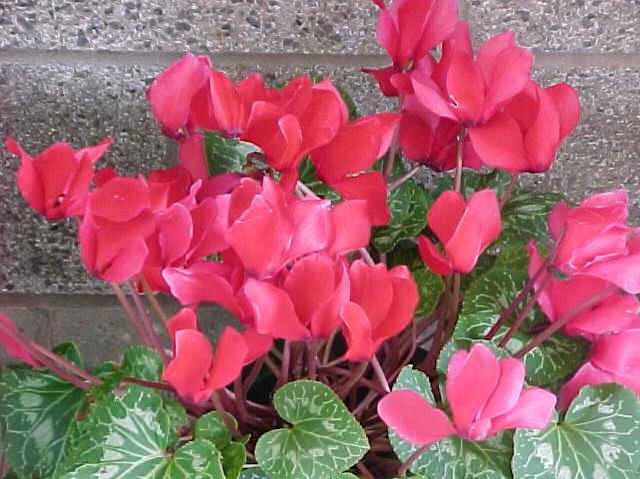Cyclamen (Cyclamen Persicum)
Cyclamen
C. persicum is native to open, rocky soils and crevices in parts of the eastern and southern Mediterranean. Species flowers are rose-pink to lavender-white or white. Florist’s cyclamen are frost-tender hybrids derived from C. persicum. They feature clumps of long-stalked basal dark green leaves often variegated with silver blotching or veining. Solitary flowers with twisted and reflexed petals bloom from winter to spring atop leafless stems rising 6-9″ tall. These hybrids offer a much greater range of flower colors than the species, including violet, lavender, purple, pink, rose, red and white, often with red centers. In contrast to florist’s cyclamen, the other type of cyclamen, species cyclamen, consists of a number of different species plants that typically are smaller (2-5″ tall) and usually have much better winter hardiness (USDA Zones 5 to – . C. hederifolium, for example, may be grown in the ground year-round in St. Louis with a protected location and winter mulch.
Genus name comes from the Greek word presumably from kylos meaning circle and referring to the rounded tubers.
Specific epithet means Persian.

Best grown in pots in light, organically rich, well-drained soils in part shade to full shade. Plants are only winter hardy to USDA Zones 9-11, but can be grown as indoor plants in cooler zones. Blooms in winter (December to April). Best with intense indirect indoor light in cool (65°F) locations. Plants go dormant in summer (lose most if not all leaves) and should be infrequently watered during this period. As cool fall temperatures arrive, plants begin to grow again and regular watering and fertilization should be resumed. May be grown from seed planted in late summer for first bloom the following winter (about 18 months later).
| Hardiness zone | 9 - 11 |
| Sun light | Part Shade |
| Water | Medium |
| Maintenance | Medium |
Susceptible to bacterial soft rot of the tubers, pythium root rot, fusarium wilt, botrytis, powdery mildew and various mosaic and ringspot viruses. Too much direct sun can lead to sun scorch. Cyclamen mites are by far the most damaging invertebrate pest of florist cyclamen and cause puckering, stunting, and deformation of new foliage and flowers. Watch for aphids and spider mites.
Indoor pots, containers. Where winter hardy it is often used as a winter annual rather than a perennial.
| Common name | Cyclamen |
| Botanical name | Cyclamen Persicum |
| Plant type | Bulb |
| Family | Primulaceae |
| Hardiness zone | 9 - 11 |
| Water | Medium |
| Maintenance | Medium |
| Flower color | Pink, Red, Violet, Lavender And White |
| Flowering period | November - March |
| Height | 0.50 To 0.75 Feet |
| Width | 0.50 To 0.75 Feet |